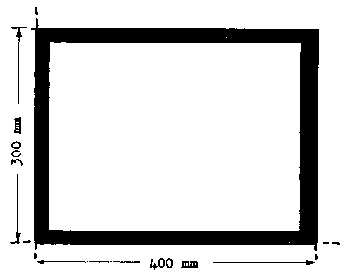Part IRequirements
1. At all times when explosives are carried—
(a)two blank rectangular reflectorised orange-coloured plates conforming to the requirements of paragraphs 2 and 4 shall be affixed, one at the front and the other at the rear of the vehicle,
(b)two placards conforming to the requirements of paragraphs 3 to 8 shall be affixed, one to each side of the vehicle, trailer, semi-trailer or freight container in which the explosives are actually carried.
2. Each plate referred to in paragraph 1(a) shall—
(a)be in the form of the following diagram and comply with the measurements in the diagram, and
(b)have a black border not more than 15 millimetres wide.
3. Each placard referred to in paragraph 1(b) shall—
(a)be in the form of a square set with its side at an angle of 45 degs to the vertical, and
(b)have an orange-coloured background with a black border; and any figure, letter or pictograph required by the following provisions of this Schedule shall be in black.
4. Each plate and placard referred to in paragraph 1 shall—
(a)be clearly visible,
(b)so far as is reasonably practicable, be kept clean and free from obstruction at all times when explosives are being carried, and
(c)be completely covered or completely removed when all explosives have been removed from the vehicle, trailer, semi-trailer or freight container on which it was displayed.
5. In the case of explosives in Division 1.1, 1.2 or 1.3 each placard referred to in paragraph 1(b) shall—
(a)be in the form of the following diagram (the Division number “1.2” and the Compatibility Group letter “E” are only examples);
(b)comply with the measurements in the diagram except that larger measurements may be used in which case the measurements shall be increased proportionally;
(c)have a pictograph of a bomb blast filling most of its upper half;
(d)have the Division number and Compatibility Group letter appropriate to the explosives being carried written in its lower half; and
(e)have the class number “1” written in its bottom corner below the Division number and Compatibility Group letter.
6. In the case of explosives in Division 1.4 or 1.5 each placard referred to in paragraph 1(b) shall—
(a)be in the form of the following diagram (the Division number “1.4” and the Compatibility Group letter “E” are only examples);
(b)comply with the measurements in the diagram except that larger measurements may be used in which case the measurements shall be increased proportionally;
(c)have the Division number appropriate to the explosives being carried written on its upper half;
(d)have the Compatibility Group letter appropriate to the explosives being carried written on its lower half; and
(e)have the class number “1” written in its bottom corner below the Compatibility Group letter.
7. In the case of a vehicle carrying explosives of different Compatibility Groups, no Compatibility Group letter shall be written on the placards.
8. In the case of explosives which are carried solely in connection with an application for their classification, each placard referred to in paragraph 1(b) shall—
(a)be in the form of the following diagram; and
(b)comply with the measurements in the diagram, except that larger measurements may be used in which case the measurements shall be increased proportionally.




